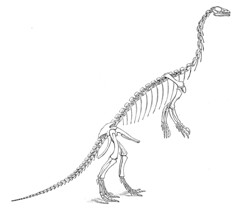Paleo: You say prosauropod; I say sauropod…
There are few places in the world where a few fragmentary pieces of dinosaur bones could command constant scrutiny for nearly two centuries. The Connecticut Valley is one of those places, and the bones of a small plant-eating dinosaur found here, logged in the Yale Peabody Museum collection as catalog number YPM 2125, are such bones.
Their true nature has been the subject of much debate from the time the bones were first discovered, during blasting for a well in East Windsor, Connecticut in 1818, right up until the present. They were found decades before dinosaurs were even known, and there was doubt at first as to whether the bones were animal or human.
The first accounts were published by Benjamin Silliman, a pioneer of geology in the New World, in his "American Journal of Science." Other descriptions and mentions continued to be published in the 1830s, 40s, and 50s, by such renowned scholars as Rev. Edward Hitchcock and Dr. Jeffries Wyman.

It wasn’t until 1896 that the infamous bone hunter, O. C. Marsh, first declared “the Bones from the Well” to be dinosaurian—presumably a prosauropod similar to specimens of Anchisaurus and Ammosaurus Marsh collected from the Wolcott Quarry in Manchester, in an area that today includes the Buckland Hills Mall.
Early in the 20th century, the renowned paleontologist Richard Swann Lull made his own careful appraisals of “the Bones from the Well.” University of Bridgeport paleontologist Peter Galton published the findings of studies he made of the bones in the 1970s.
All reached a similar conclusion, that the bones listed as YPM 2125 were those of a prosauropod, an early form of plant-eater that was among the first to develop a body type later perfected by the huge sauropod dinosaurs of Late Jurassic time, beasts such as the giant Apatosaurus seen today in the Great Hall at the Peabody.
That was until British paleontologist Adam Yates published the newest in the long line of studies of “the Bones from the Well” in April of 2004. Yates argued that YPM 2125 wasn’t a prosauropod after all, but one of the earliest known of the sauropod dinosaurs instead.
The bones survive today as little more than chalky smudges in blocks of Connecticut Valley brownstone. While the debate as to their true nature still rages, one thing is for sure. The specimen Silliman marked with the initials “B.S.” nearly two centuries ago stand today as “the earliest verifiable discovery of dinosaur bones in North America.”
0 Comments:
Post a Comment
<< Home